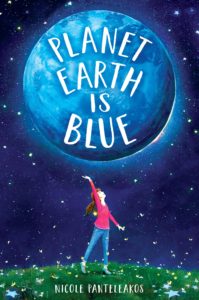 It’s January 1986, and 12-year-old Nova Vizina is living in yet another foster home after she and her older sister, Bridget, were removed from their mentally ill mother when Nova was five. Nova is autistic and nonverbal, and she has survived a series of emotional blows, the latest of which is 17-year-old Bridget’s disappearance. Bridget told her she had to go away from their last foster home, but she’d be back in time to see the launch of the Challenger space shuttle carrying teacher Christa McAuliffe from their home state of New Hampshire. Outer space is a special interest the two sisters share, along with the David Bowie song “Space Oddity” from which the book’s title is drawn.
It’s January 1986, and 12-year-old Nova Vizina is living in yet another foster home after she and her older sister, Bridget, were removed from their mentally ill mother when Nova was five. Nova is autistic and nonverbal, and she has survived a series of emotional blows, the latest of which is 17-year-old Bridget’s disappearance. Bridget told her she had to go away from their last foster home, but she’d be back in time to see the launch of the Challenger space shuttle carrying teacher Christa McAuliffe from their home state of New Hampshire. Outer space is a special interest the two sisters share, along with the David Bowie song “Space Oddity” from which the book’s title is drawn.
Nova’s new foster parents are kind, loving, and patient, and while she struggles to adjust to her new school, she makes friends with other kids in the special education class. Through her first-person narrative interspersed with letters to Bridget, readers see Nova’s rich internal life and how she wants to express it. She knows that too many people consider her incapable of the things she can do, including knowing how to read, which Bridget taught her. How can she make them see her the way Bridget already does? The space shuttle’s launch takes on outsized importance for this reason, and through it, debut author Nicole Panteleakos explores a neurodivergent child’s experience of a shared tragedy.
Through her own experience on the autism spectrum and thorough research Panteleakos gives readers a thoughtful and convincing portrayal of her autistic protagonist. While this is a story of courage and resilience, the author avoids the trap of inspiration porn by placing readers inside Nova’s mind, exploring her insecurities as well as the strength she has drawn from both her survivalist mother, whose building of shelters created a comforting, secure environment for Nova in her early years, and her sister who has always been there for her while dealing with her own adolescent issues. In fact, Nova’s keen observation of Bridget’s life is one of the most compelling parts of the novel, and the mystery of Bridget’s disappearance, in tandem with the countdown to the shuttle’s launch, keeps the reader immersed in the story. The structure of the novel works beautifully in tandem with the characterizations. Planet Earth Is Blue is an ideal complement to Padma Venkatraman’s The Bridge Home – two middle grade novels with sisters, one neurodivergent and one neurotypical caring for each other, but read together presenting the perspective of each.